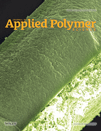Improving water solubility of poly(acrylic acid-co-styrene) copolymers by adding styrene sulfonic acid as a termonomer
Abstract
Acrylic acid is often used to make water-soluble polymers while styrene is often modified to add special functions to polymers. However, when styrene and acrylic acid are copolymerized, the resulting polymer is much less water soluble. To regain water solubility, the effect of styrene sulfonic acid on solubility of poly(acrylic acid-co-styrene) copolymers was investigated. Even though acrylic acid polymers are known for their water solubility, the presence of styrene units within acrylic acid copolymers reduces the solubility of the copolymer substantially at the natural pH of the solutions. By adding styrene sulfonic acid as a termonomer, polymers that are water soluble at the natural pH of the polymerization could be obtained. The solubility of the polymer after removal of the solvent and by redissolving at different concentrations and pH levels is also reported. Solubility increases at higher pH especially with low styrene concentration in the copolymer. It was found that incorporation of as little as 5 mol % of styrene into poly(acrylic acid) reduced the aqueous solubility to less than 0.5 g dL−1 at pH 7. Upon adding 7 mol % styrene sulfonic acid as a termonomer, the water solubility increased to 5 g dL−1 at pH 7. At higher levels of styrene, more styrene sulfonic acid was needed, especially at low pH. © 2013 Wiley Periodicals, Inc. J. Appl. Polym. Sci., 2013




